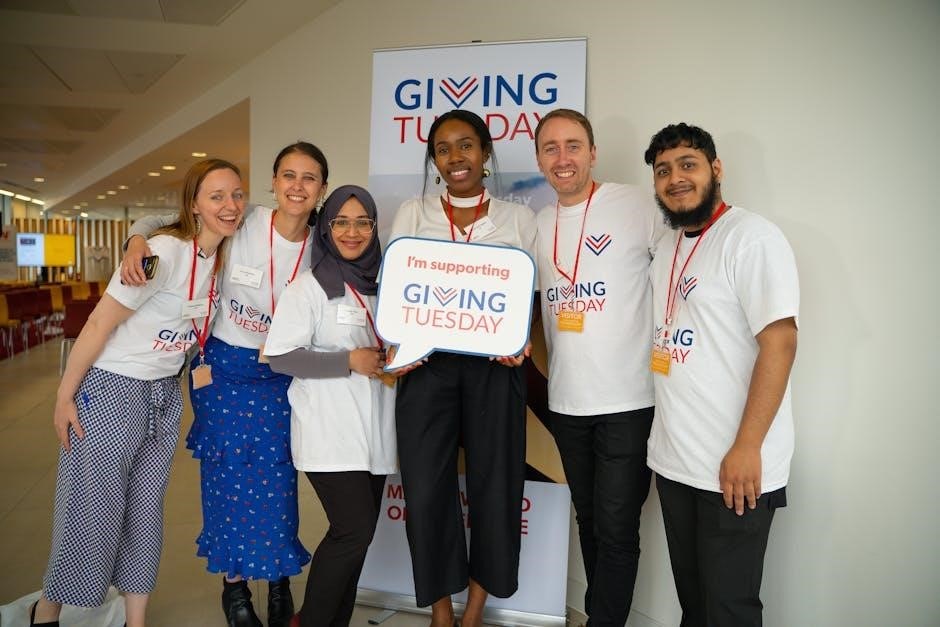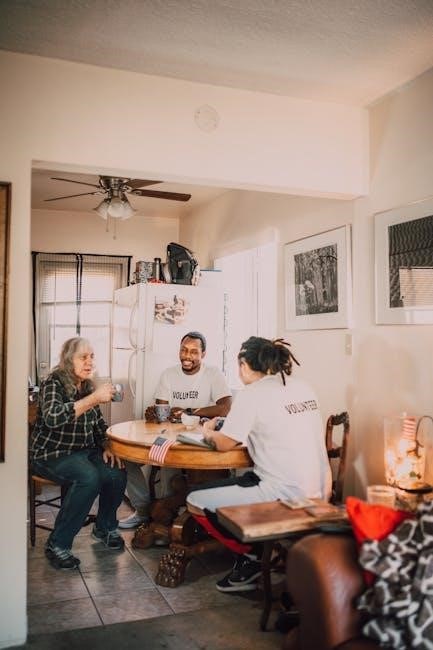Nonprofit fundraising is crucial for sustaining operations and achieving mission goals. It involves creative strategies to engage donors, build relationships, and secure resources, ensuring long-term impact and growth.
1.1 The Importance of Fundraising for Nonprofits
Fundraising is vital for nonprofits as it secures resources to sustain operations and achieve mission goals. It fosters community engagement, builds donor relationships, and raises awareness about the organization’s cause. Effective fundraising not only generates revenue but also strengthens trust and credibility. By leveraging creative strategies, nonprofits can diversify funding sources, ensuring long-term sustainability and impact. Successful fundraising efforts often lead to increased donor retention and stronger community ties, which are essential for advancing social change and addressing critical needs.
1.2 Overview of Common Fundraising Strategies
Common fundraising strategies for nonprofits include event-based initiatives like charity runs, auctions, and galas, as well as digital approaches such as social media campaigns and email marketing. Direct donation programs, like monthly giving and major gifts, are also effective. Corporate partnerships, grant writing, and product sales further diversify funding sources. These strategies help nonprofits build donor relationships, increase visibility, and sustain their missions. Each approach requires careful planning and alignment with the organization’s goals to maximize impact.

Event-Based Fundraising Ideas
Event-based fundraising ideas include charity runs, auctions, galas, dinners, luncheons, crowdfunding campaigns, tribute events, and virtual fundraising. These strategies engage communities, raise funds, and build awareness effectively.
2.1 Charity Runs and Walks
Charity runs and walks are popular fundraising tools that engage participants and build community support. These events encourage physical activity while raising funds for a cause. Participants often collect pledges or pay registration fees, with proceeds going directly to the nonprofit. Sponsorships from local businesses can further boost revenue. Promoting the event through social media and flyers helps attract more participants and donors. Such events foster a sense of camaraderie and shared purpose, making them a successful and sustainable fundraising strategy.
2.2 Auctions and Galas
Auctions and galas are sophisticated fundraising events that combine entertainment with philanthropy. They often feature live or silent auctions of exclusive items, such as luxury goods, experiences, or artwork. Ticket sales, sponsorships, and donations further boost revenue. These events foster a sense of community and prestige, attracting high-profile donors. Proper promotion and engagement with attendees are key to maximizing impact. Auctions and galas not only raise funds but also strengthen relationships with supporters and enhance the nonprofit’s visibility.
2.3 Fundraising Dinners and Luncheons
Fundraising dinners and luncheons are engaging events that bring donors together for a shared cause. These gatherings often feature keynote speakers, live auctions, or raffles, creating a memorable experience. Sponsors can underwrite tables or meals, increasing revenue. Personal stories from beneficiaries can deepen emotional connections, encouraging larger donations. These events not only raise funds but also foster relationships and community support, making them a valuable tool for nonprofits to build loyalty and awareness.
2.4 Crowdfunding Campaigns
Crowdfunding campaigns leverage online platforms to raise funds from a large number of people, typically through social sharing. These campaigns are effective for their viral potential and ability to engage a broad audience. Nonprofits can use platforms like Kickstarter or GoFundMe to share compelling stories and set clear goals. Promoting campaigns through email, social media, and influencers can amplify reach. Regular updates and donor recognition help maintain engagement and encourage contributions. This method is ideal for projects with widespread appeal.
2.5 Tribute Events and Memorials
Tribute events and memorials honor individuals, groups, or causes, fostering emotional connections and community involvement. These events often include dedications, storytelling, or memory walks, creating meaningful experiences for participants. They can be paired with fundraising activities like donations in someone’s name or sponsored tributes. Transparency in how funds are used strengthens trust and encourages contributions. These events not only raise money but also build lasting relationships with supporters, ensuring a lasting impact for the nonprofit’s mission.
Digital Fundraising Strategies
Digital fundraising strategies leverage online platforms to engage donors globally. Tools like social media, email marketing, and online donation platforms streamline contributions, enhancing accessibility and reach for nonprofits.

3.1 Social Media Fundraising
Social media fundraising harnesses platforms like Facebook, Instagram, and Twitter to engage donors and amplify causes. Nonprofits can share compelling stories, use donation buttons, and create shareable content to inspire giving. Platforms like Facebook Fundraisers and Instagram’s donation stickers simplify contributions. Peer-to-peer campaigns and live fundraising events further enhance reach. By leveraging visuals and storytelling, nonprofits can build emotional connections and drive immediate action, making social media a powerful tool for modern fundraising efforts.
3.2 Email Marketing for Donations
Email marketing is a powerful tool for nonprofit fundraising, enabling direct communication with supporters. Personalized emails with compelling stories and clear calls-to-action can inspire donations. Segmented lists ensure relevance, boosting engagement. Regular newsletters, updates, and appeals keep donors informed and invested. Consistent follow-ups and gratitude expressions strengthen relationships, fostering long-term support. Effective email campaigns can significantly enhance donor retention and overall fundraising success, making them a cornerstone of nonprofit communication strategies.
3.3 Online Donation Platforms
Online donation platforms are essential tools for nonprofits, enabling seamless and secure contributions. Platforms like Classy, Qgiv, and Network for Good offer customizable donation pages, recurring giving options, and peer-to-peer fundraising capabilities. These tools streamline the donation process, making it easy for supporters to contribute anytime, anywhere. Integration with CRM systems and analytics features help nonprofits track performance and engage donors effectively. By leveraging these platforms, organizations can enhance donor experiences and maximize fundraising potential, ensuring sustainable growth and mission impact.
3.4 Virtual Fundraising Events
Virtual fundraising events have become a cornerstone of nonprofit strategies, offering flexibility and accessibility. From webinars and online auctions to live Q&A sessions, these events engage global audiences. Platforms like Zoom and Facebook Live enable real-time interaction, fostering connection and participation. Virtual galas, charity runs, and crowdfunding campaigns also thrive online, reducing costs and expanding reach. These events not only raise funds but also build community and awareness, making them a vital tool for modern nonprofits aiming to inspire and mobilize supporters worldwide.

Direct Donation and Membership Programs
Direct donation and membership programs are vital for nonprofit sustainability. They foster long-term engagement through monthly giving, donor retention strategies, and exclusive member benefits, ensuring consistent support.
4.1 Monthly Giving Programs

Monthly giving programs provide a steady revenue stream for nonprofits, fostering long-term donor engagement. By automating recurring donations, organizations ensure consistent support and reduce fundraising efforts. These programs encourage donors to contribute smaller, manageable amounts regularly, creating a predictable income source. Personalized communication and recognition further strengthen donor relationships, increasing retention rates. Monthly giving is a sustainable strategy that aligns donor habits with organizational needs, ensuring continuous impact and financial stability.
4.2 Major Gifts and Donor Solicitation
Major gifts are significant donations from high-capacity donors, often secured through personalized solicitation. Nonprofits identify potential donors through research and relationship-building, ensuring alignment with their mission. Solicitation strategies include one-on-one meetings, tailored proposals, and stewardship events. Recognizing donors through naming opportunities or exclusive updates fosters loyalty. Major gifts provide substantial funding for specific projects or operational needs, enabling nonprofits to achieve impactful goals while strengthening donor relationships and trust. This approach requires strategic planning and consistent engagement.
4.3 Membership Drives and Benefits
Membership drives are a powerful way to build a loyal supporter base. Nonprofits offer exclusive benefits like discounts, event access, or recognition to attract and retain members. Tailoring benefits to different membership tiers can incentivize higher contributions. Regular communication and updates keep members engaged, fostering a sense of community. Effective membership drives not only generate steady revenue but also create long-term advocates for the organization’s mission. This approach strengthens donor relationships and ensures sustained support.
Corporate Partnerships and Sponsorships
Corporate partnerships and sponsorships align nonprofit missions with business values, offering financial support and brand visibility. These collaborations can include event sponsorships, cause-related marketing, and employee matching programs.
5.1 Securing Corporate Sponsors
Securing corporate sponsors involves aligning your nonprofit’s mission with a company’s values and goals. Research potential sponsors whose target audience matches your donor base. Develop a compelling proposal highlighting mutual benefits, such as brand visibility and community engagement. Offer tailored sponsorship packages, including event participation, logo placement, and social media promotion. Building relationships through regular updates and recognition can foster long-term partnerships and recurring support. This collaboration not only secures funding but also strengthens community ties and enhances corporate social responsibility efforts.
5.2 Cause-Related Marketing
Cause-related marketing pairs nonprofits with businesses, creating campaigns where a portion of sales supports the nonprofit’s mission. This strategy enhances brand visibility for companies while fostering goodwill. Nonprofits benefit from consistent funding and expanded reach. Examples include co-branded products or “give-back” days. By aligning with corporate partners, nonprofits can amplify their impact and build lasting relationships with supporters. This approach not only drives donations but also strengthens community engagement and trust in the organization. It’s a win-win for both parties involved.
5.3 Employee Giving and Matching Programs
Employee giving and matching programs are powerful tools for nonprofits. These initiatives encourage employees to donate to causes they care about, with companies often matching their contributions. This not only increases donation amounts but also fosters a culture of philanthropy within organizations. Nonprofits can partner with businesses to promote these programs, enhancing their fundraising potential. By leveraging employee engagement and corporate matching, nonprofits can amplify their impact and build stronger relationships with both donors and sponsors. This strategy is both effective and sustainable.
Recurring Giving and Donor Retention
Recurring giving ensures steady income for nonprofits, while donor retention focuses on maintaining long-term supporter relationships. Both strategies are vital for sustainable growth and mission fulfillment.

6.1 Strategies for Increasing Recurring Donations
To boost recurring donations, nonprofits should emphasize the impact of steady support, offer incentives for monthly giving, and simplify the donation process. Highlighting the benefits of recurring gifts, such as consistent funding for programs, can motivate donors. Additionally, personalized communication and regular updates on how donations are used can foster loyalty. Recognizing recurring donors through exclusive acknowledgments or tiers can also encourage long-term commitment. These strategies help build a reliable revenue stream, ensuring sustained mission impact.
6.2 Donor Retention Best Practices
Effective donor retention begins with personalized communication and expressing genuine gratitude. Regular updates on how donations are used help donors feel connected to the cause. Recognizing donors through acknowledgment programs or exclusive events fosters loyalty. Consistent engagement, such as newsletters and social media updates, keeps donors informed and invested. Additionally, offering feedback opportunities ensures donors feel valued and heard, strengthening their commitment to the organization. Building strong relationships is key to long-term donor retention and sustained support.

Grant Writing and Foundations
Grant writing is a vital nonprofit fundraising strategy, involving research, relationship-building, and compelling proposals to secure funding from foundations that align with the organization’s mission and goals.
7.1 Researching and Applying for Grants
Researching and applying for grants is a cornerstone of nonprofit fundraising. Identify foundations that align with your mission and review their funding priorities. Develop a tailored approach for each application, emphasizing the impact of your work. Ensure your proposal includes a clear budget, objectives, and evaluation metrics. Build relationships with program officers to gain insights and improve your chances of success. Allow ample time for the application process and thoroughly understand each foundation’s specific requirements and deadlines.
7.2 Building Relationships with Foundations
Building strong relationships with foundations is vital for long-term funding success. Engage foundation representatives through personalized communication, updates, and invitations to events. Share your nonprofit’s achievements and challenges to demonstrate transparency and impact. Regularly update them on how their grants are making a difference. Attend foundation-hosted webinars and workshops to stay informed about their priorities. Consistent, genuine communication fosters trust and can lead to sustained support and larger grants over time.
7.3 Writing Effective Grant Proposals
Crafting compelling grant proposals is essential for securing foundation funding. Clearly articulate your nonprofit’s mission, goals, and the specific project’s impact. Ensure alignment with the foundation’s priorities and values. Provide detailed budgets, timelines, and measurable outcomes. Highlight your organization’s expertise and past successes. Use a persuasive narrative to convey urgency and need. Include testimonials or data to strengthen credibility. Professional formatting and adherence to guidelines are crucial for making a positive impression and increasing the likelihood of approval.

Product Sales and Merchandise
Selling branded merchandise, like t-shirts, mugs, and tote bags, is a popular nonprofit fundraising strategy. Seasonal items, such as holiday-themed products, can also boost revenue and engagement.
8.1 Selling Branded Merchandise
Selling branded merchandise is a popular nonprofit fundraising strategy. Organizations can create custom items like t-shirts, mugs, and tote bags featuring their logo or mission statement. These products serve as walking billboards, promoting the nonprofit while generating revenue. Offering high-quality, visually appealing items ensures repeat purchases. Seasonal merchandise, such as holiday-themed products, can also boost sales. Online stores and event booths are effective platforms for selling these goods, making it easy for supporters to contribute while receiving something tangible in return. This approach builds brand awareness and fosters community engagement.
8.2 Bake Sales and Food-Related Fundraisers
Bake sales and food-related fundraisers are timeless and effective ways for nonprofits to raise funds. These events foster community engagement and offer a tangible way for supporters to contribute. Traditional bake sales can be enhanced with themed events, such as holiday cookie sales or cultural cuisine showcases. Additionally, partnering with local bakeries or restaurants for donations can increase proceeds. Modern twists, like food trucks or online pre-orders, expand reach. These events not only generate revenue but also build goodwill and visibility for the organization.
8.3 Seasonal and Holiday-Themed Sales
Seasonal and holiday-themed sales are a powerful fundraising strategy, leveraging festive spirit to drive engagement. Nonprofits can capitalize on major holidays like Christmas, Halloween, or Easter by selling themed merchandise, such as ornaments, costumes, or gift baskets. Additionally, offering seasonal products like holiday cookies, candles, or calendars can attract donors looking for meaningful gifts. These campaigns create a sense of urgency and alignment with community traditions, making them highly effective for generating both funds and goodwill.
Community Engagement and Outreach
Community engagement strengthens connections, fostering trust and support. Activities like volunteer days, neighborhood clean-up drives, or cultural fairs build relationships, encouraging donations and long-term involvement.
9.1 Hosting Volunteer Events
Hosting volunteer events is a powerful way to engage the community and foster support for your nonprofit. By organizing activities like clean-up drives, charity runs, or food drives, you can bring people together while raising funds. These events not only build relationships but also create opportunities for hands-on involvement. Encourage teams to participate, offer recognition for contributions, and share stories of impact to inspire further support. Volunteer events are a win-win, benefiting both your cause and the community.
9.2 Community Challenges and Competitions
Community challenges and competitions are engaging fundraising strategies that encourage participation and friendly rivalry. By setting achievable goals, nonprofits can motivate individuals or teams to contribute. For example, fitness challenges or fundraising contests can drive donations while fostering a sense of accomplishment. Recognizing top performers and sharing success stories can amplify engagement. These events not only raise funds but also strengthen community bonds and promote your mission effectively. They are dynamic tools for building lasting supporter relationships.
Educational Resources for Fundraising
Educational resources empower nonprofits with practical knowledge and innovative strategies. eBooks, webinars, and workshops provide insights into effective fundraising techniques, helping organizations maximize their impact and reach.
10.1 eBooks and Guides on Fundraising
eBooks and guides on fundraising offer nonprofits practical strategies and real-world examples to enhance their efforts. These resources cover topics like donor engagement, digital campaigns, and event planning, providing actionable insights. Many guides are tailored to specific nonprofit needs, ensuring relevance and effectiveness. They often include expert tips, case studies, and step-by-step instructions, making them invaluable tools for organizations aiming to diversify and optimize their fundraising approaches. Accessible and affordable, these resources empower nonprofits to achieve their goals efficiently.
10.2 Webinars and Online Courses
Webinars and online courses provide nonprofits with accessible, flexible learning opportunities to enhance fundraising skills. These resources cover diverse topics, from digital strategies to donor engagement, often led by industry experts. Interactive sessions and downloadable materials make learning engaging and practical. Nonprofits can gain insights into the latest trends and best practices, helping them stay competitive and effective in their fundraising efforts. These platforms also offer certifications, adding credibility to their operations and fostering professional growth within their teams.
10.3 Workshops and Seminars
Workshops and seminars offer nonprofits interactive learning experiences, focusing on practical fundraising strategies and tools. These events cover topics like donor engagement, grant writing, and digital fundraising, often featuring expert speakers. Participants gain hands-on experience through exercises and group discussions. Networking opportunities allow professionals to share ideas and build connections. Workshops also provide access to resources and templates, helping nonprofits implement effective fundraising campaigns. These events are invaluable for staying updated on industry trends and enhancing overall fundraising capabilities.

Conclusion
Effective nonprofit fundraising requires creativity, community engagement, and sustainable strategies. By leveraging diverse methods, organizations can build lasting donor relationships and achieve their missions successfully.

11.1 Final Thoughts on Effective Fundraising
Effective fundraising is the backbone of nonprofit success, enabling organizations to fulfill their missions and create lasting impact. By combining innovative strategies, building strong donor relationships, and leveraging digital tools, nonprofits can secure the resources needed to thrive. Continuous adaptation to evolving trends and community needs ensures long-term sustainability and growth, ultimately driving meaningful change and fostering a loyal supporter base for years to come.
11.2 Encouraging Creativity and Community Involvement
Fostering creativity and community involvement is vital for successful nonprofit fundraising. Engaging local businesses, schools, and individuals through unique events and initiatives can build a sense of ownership and shared purpose. By encouraging innovative ideas and collaboration, nonprofits can tap into the collective energy of their community, creating memorable experiences that drive support and strengthen connections, ultimately leading to sustained engagement and impactful results for the organization’s mission.